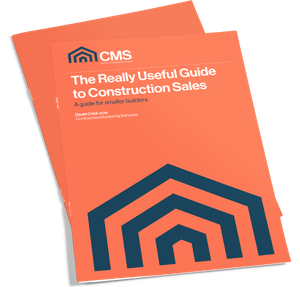If you’ve set up your criteria correctly, you’ll now be getting a stream of potential projects from your sales lead provider. For example, a smaller builder might focus on architect-led projects in the £100k-£400k range, within an hour’s drive. It’s a good strategy: architect-led projects offer four to six-month build periods, and reliable cash-flow based on architects’ valuations. For them, that’s where growth lies, and a thriving business with a healthy work-life balance.
Those are what I call the A* jobs. What are yours?
A* projects will be those that meet all your needs. Every week, ruthlessly eliminate any projects that aren’t right for you. Then select the most promising project leads to follow up each week by telephone. If you were to follow up 8-10 quality new leads a week, I’d expect to net perhaps 2 - 4 targeted tenders every month.
Be wary of taking on too much. Only go for A* projects, and concentrate on a manageable number each week. Focus on the very best opportunities; it will pay you dividends.
Remember what I said at the outset, that marketing is about communicating information, and sales is about building relationships. That means that you’re using sales leads to find clients, not just jobs. Perhaps an architect doesn’t have the right project for you at this moment, but you’d like to work with them in future. Use the sales lead to get in touch and get on their radar for next time. When a project comes up that’s a good fit for you, they’ll already know your name.
A good sales person brings in tendering opportunities, but they’re also building a network, compiling a contacts book, getting to know a wide range of work providers and raising your profile among the right people.
Those looking for a quick win might want to contact past clients first. Perhaps there’s someone you used to work with in the past. Even if a few years have gone by, there’s a good chance they’ll remember you if you get in touch. It’s easier to renew an old business relationship than create one from scratch, so see if you can resurrect some old contacts.
I also look out for what I call ‘aliens’: architects or developers working outside of their usual patch. If they don’t work in your area often, they won’t have as many contacts and you have a better chance of winning the work if you introduce yourself.
If you’ve got an eye on growing your business, then be ambitious in what you pitch for. You know what you realistically have a chance of winning, but use sales leads to get your name in the hat for slightly bigger contracts than you’re used to. It can be more work to chase down these jobs, so you want to go after three or four bread-and-butter projects for every bigger one. I call them flagships, because they’re the jobs you’ll want to put front and centre on the website, and feature as case studies. Don’t chase all big jobs. Bigger tenders will come quite naturally as you prove yourself. But see if you can take on one flagship project at a time, balanced with two or three medium jobs and some smaller ones. It’ll get the best out of your workforce and help to maintain cash flow.
Using sales leads in this way can get a business out of a rut of similar jobs, and onto the kinds of projects you’ve always wanted to do.

